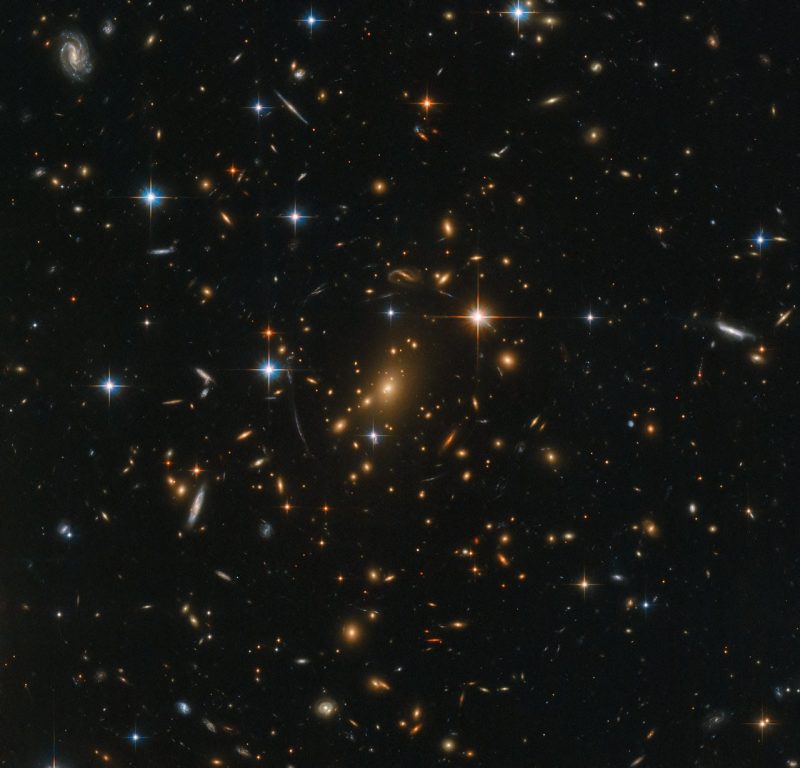Back to the space telescope!
I cannot stop engaging in Hubble stories and republishing them in this place.
The latest is an account, published here, of how scientists turned an image of a galaxy into music! Or rather added music to the video.
Here it is!
ooOOoo
Cool! A Hubble photo translated to music
Posted by Deborah Byrd in Human World | Space | May 10, 2020
There’s no sound in space. But – working with NASA – musicians and scientists turned a Hubble Space Telescope image of a galaxy cluster into music.
We stumbled on this video via a May 3, 2020, re-post at ScienceAlert. Matt Russo and Andrew Santaguida of System Sounds in Toronto – which calls itself “a sci-art outreach project” – created the video. It’s part of NASA’s Astrophysics Visualizations series. NASA explained the video this way:
Space becomes sonified in this visualization of a cluster of galaxies imaged by NASA’s Hubble Space Telescope. Time flows left to right, and the frequency of sound changes from bottom to top, ranging from 30 to 1,000 hertz. Objects near the bottom of the image produce lower notes, while those near the top produce higher ones. Most of the visible specks are galaxies housing countless stars. A few individual stars shine brightly in the foreground. Stars and compact galaxies create short, clear tones, while sprawling spiral galaxies emit longer notes that change pitch. The higher density of galaxies near the center of the image – the heart of this galaxy cluster, known as RXC J0142.9+4438 – results in a swell of mid-range tones halfway through the video. Hubble’s Advanced Camera for Surveys and Wide Field Camera 3 acquired this image on August 13, 2018.
Cool!

Here’s the original Hubble image of galaxy cluster RXC J0142.9+4438, later “sonified” by Russo and Santaguida. NASA wrote: “Galaxies abound in this spectacular Hubble image; spiral arms swirl in all colors and orientations, and fuzzy ellipticals can be seen speckled across the frame as softly glowing smudges on the sky. Each visible speck of a galaxy is home to countless stars. A few stars closer to home shine brightly in the foreground, while a massive galaxy cluster nestles at the very center of the image; an immense collection of maybe thousands of galaxies, all held together by the relentless force of gravity.” Read more about this image, which is via ESA/ Hubble & NASA, RELICS.
Bottom line: Musicians and scientists turned a Hubble Space Telescope image – of galaxy cluster RXC J0142.9+4438 – into music.
ooOOoo
That is so lovely.
It’s only just over half a minute long but is still precious!
And I learnt a new word: sonification!
I loved this and the explanation of how they made it. Although, the music is very eerie. Still beautiful that it could be sonified.
LikeLike
Yes Susan, many congratulations to the team that made it happen!
LikeLiked by 1 person
Reblogged this on Wibble and commented:
This is a really cool post from Paul Handover of Learning from Dogs. Check out these other Hubble posts of his, too:
+ Thirty years of Hubble
+ More on the magnificent Hubble
LikeLike
Thanks Colin!
LikeLike
My pleasure. Thank you for providing such entertaining content!
LikeLike
🙂
LikeLiked by 1 person
The Universe is Just AMAZING…. Loved the video share. 🙂
Hope you are both well Paul 🙂
LikeLike
As someone said, space is the final frontier, but that frontier is so, so far away now. Dear Sue, you understand my fascination with the universe. It puts all our experiences of Planet Earth, of humans, into perspective. It is just AMAZING! 😊
LikeLiked by 1 person
Yes this small blue dot is very precious to us, but its just a microscopic particle within the schemes of things.. 🙂
LikeLike
Our solar system, let alone our planet, is an infinitesimally small part of the universe. We humans are totally incapable of fully understanding it. Some of us, dear Sue, just ponder in awe.
LikeLiked by 1 person
That’s why we can never begin to explain it all… Because there is just Sooooo, much we do not know.. 🙂
LikeLike
Agreed! I still look up at the night sky, which is just a small part of our solar system, and try to relax in not knowing. In fact, for me it’s the only place where my brain really slows down!
LikeLiked by 1 person
🙂
LikeLike